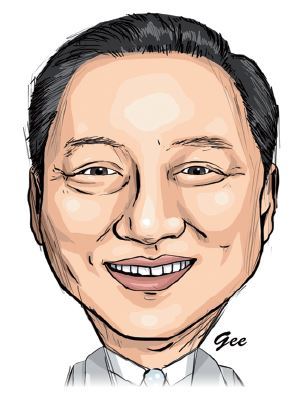
The head of Korea’s largest business association called for calm and objectivity amid heavy criticism against the South Korean government for its lack of effort to participate in the recently-concluded Trans-Pacific Partnership.
“Many have been criticizing that Korea has missed out on a huge market that takes up 40 percent of the global economy by not partaking in the TPP. I ask everyone to calm down and take on a more objective viewpoint,” said Park Yong-maan, the chairman of the Korea Chamber of Commerce and Industry, via his Facebook account on Wednesday.
Park pointed out that it will take around one to two years for the TPP to go into effect, adding that Korea can take on the necessary steps to join the regional trade pact during this period.
Responding to claims that Korea would potentially face disadvantages as a latecomer, the chairman said Korea would “never have been met with satisfactory conditions even if it had joined as a founding member.”
The U.S. may have pushed Korea on issues it had budged on in the Korea-U.S. Free Trade Agreement such as the opening of Korean agricultural market, he said.
Park continued to say that Korea may have further opened its market to Japan, from which Korea already imports more than it exports.
“Given that Korea has already sealed free trade agreements with most of the TPP member states, focusing its priorities on the Korea-China FTA was an inevitable choice,” he said.
The KCCI chairman further warned against hasty conclusions and one-sided criticisms, claiming that “though the intermediary industries like the materials sector are indeed at a comparative disadvantage now (after the new trade deal), such shouldn’t be generalized to the entire economy.”
The U.S.-led Trans-Pacific Partnership reached a landmark conclusion in Atlanta on Monday after more than seven years of negotiations.
It is designed to establish one of the world’s largest free trade zones, linking and boosting commerce between the U.S., Japan and 10 Pacific Rim states, which together represent some 40 percent of the global economy valued at around $38 trillion.
By Sohn Ji-young (jys@heraldcorp.com)
“Many have been criticizing that Korea has missed out on a huge market that takes up 40 percent of the global economy by not partaking in the TPP. I ask everyone to calm down and take on a more objective viewpoint,” said Park Yong-maan, the chairman of the Korea Chamber of Commerce and Industry, via his Facebook account on Wednesday.
Park pointed out that it will take around one to two years for the TPP to go into effect, adding that Korea can take on the necessary steps to join the regional trade pact during this period.
Responding to claims that Korea would potentially face disadvantages as a latecomer, the chairman said Korea would “never have been met with satisfactory conditions even if it had joined as a founding member.”
The U.S. may have pushed Korea on issues it had budged on in the Korea-U.S. Free Trade Agreement such as the opening of Korean agricultural market, he said.
Park continued to say that Korea may have further opened its market to Japan, from which Korea already imports more than it exports.
“Given that Korea has already sealed free trade agreements with most of the TPP member states, focusing its priorities on the Korea-China FTA was an inevitable choice,” he said.
The KCCI chairman further warned against hasty conclusions and one-sided criticisms, claiming that “though the intermediary industries like the materials sector are indeed at a comparative disadvantage now (after the new trade deal), such shouldn’t be generalized to the entire economy.”
The U.S.-led Trans-Pacific Partnership reached a landmark conclusion in Atlanta on Monday after more than seven years of negotiations.
It is designed to establish one of the world’s largest free trade zones, linking and boosting commerce between the U.S., Japan and 10 Pacific Rim states, which together represent some 40 percent of the global economy valued at around $38 trillion.
By Sohn Ji-young (jys@heraldcorp.com)








![[KH Explains] Hyundai's full hybrid edge to pay off amid slow transition to pure EVs](http://res.heraldm.com/phpwas/restmb_idxmake.php?idx=644&simg=/content/image/2024/04/18/20240418050645_0.jpg&u=20240419100350)






![[From the Scene] Monks, Buddhists hail return of remains of Buddhas](http://res.heraldm.com/phpwas/restmb_idxmake.php?idx=652&simg=/content/image/2024/04/19/20240419050617_0.jpg&u=20240419175937)

![[KH Explains] Hyundai's full hybrid edge to pay off amid slow transition to pure EVs](http://res.heraldm.com/phpwas/restmb_idxmake.php?idx=652&simg=/content/image/2024/04/18/20240418050645_0.jpg&u=20240419100350)

![[Today’s K-pop] Illit drops debut single remix](http://res.heraldm.com/phpwas/restmb_idxmake.php?idx=642&simg=/content/image/2024/04/19/20240419050612_0.jpg&u=)